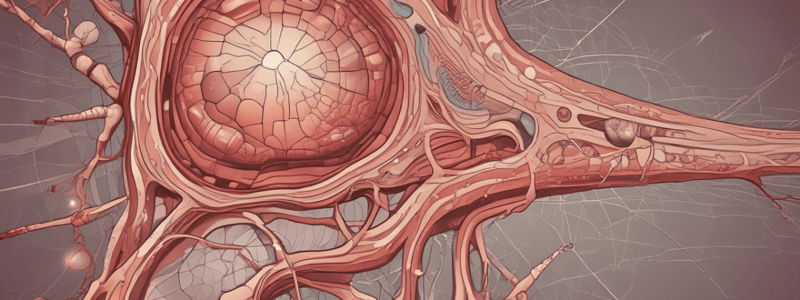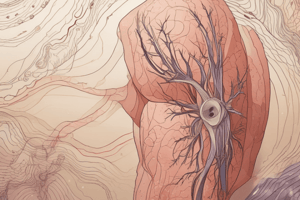Podcast
Questions and Answers
What are the two germ layers that the integumentary system structures are derived from?
What are the two germ layers that the integumentary system structures are derived from?
Ectoderm and mesoderm
What is the primary cause of the immediate threat to life in burns?
What is the primary cause of the immediate threat to life in burns?
Fluid loss, infection, and the effects of burned, dead tissue
How are burns classified?
How are burns classified?
By depth of tissue involvement
What is the characteristic of first-degree burns?
What is the characteristic of first-degree burns?
Signup and view all the answers
What is the treatment for first-degree burns?
What is the treatment for first-degree burns?
Signup and view all the answers
What is the characteristic of second-degree burns?
What is the characteristic of second-degree burns?
Signup and view all the answers
What should be done to burned limbs in second-degree burns?
What should be done to burned limbs in second-degree burns?
Signup and view all the answers
Why is applying ointments to the blisters in second-degree burns not recommended?
Why is applying ointments to the blisters in second-degree burns not recommended?
Signup and view all the answers
What are the three layers of skin that are typically destroyed in a third-degree burn?
What are the three layers of skin that are typically destroyed in a third-degree burn?
Signup and view all the answers
What is the primary concern with debridement in burn wounds?
What is the primary concern with debridement in burn wounds?
Signup and view all the answers
What is the purpose of estimating surface area of a burn using the rule of nines?
What is the purpose of estimating surface area of a burn using the rule of nines?
Signup and view all the answers
What is the criterion for a burn to be considered very severe or critical?
What is the criterion for a burn to be considered very severe or critical?
Signup and view all the answers
What is the purpose of an escharotomy in severe burn cases?
What is the purpose of an escharotomy in severe burn cases?
Signup and view all the answers
Why do individuals with severe burns require additional caloric intake?
Why do individuals with severe burns require additional caloric intake?
Signup and view all the answers
What is botulinum toxin type A (Botox) commonly used to treat?
What is botulinum toxin type A (Botox) commonly used to treat?
Signup and view all the answers
What is the duration of the effect of Botox treatment?
What is the duration of the effect of Botox treatment?
Signup and view all the answers
What is a potential adverse effect of overusing Botox?
What is a potential adverse effect of overusing Botox?
Signup and view all the answers
What is the bacterium from which botulinum toxin type A (Botox) is derived?
What is the bacterium from which botulinum toxin type A (Botox) is derived?
Signup and view all the answers
What are the two primary germ layers that form the integument?
What are the two primary germ layers that form the integument?
Signup and view all the answers
By what week of development do fingernails and toenails start to form?
By what week of development do fingernails and toenails start to form?
Signup and view all the answers
What is the function of the vernix caseosa?
What is the function of the vernix caseosa?
Signup and view all the answers
What is the result of reduced stem cell activity in the epidermis?
What is the result of reduced stem cell activity in the epidermis?
Signup and view all the answers
What is the effect of chronic UV ray exposure on the p53 gene?
What is the effect of chronic UV ray exposure on the p53 gene?
Signup and view all the answers
What is the most common type of cancer?
What is the most common type of cancer?
Signup and view all the answers
What is the result of years of particular facial expressions?
What is the result of years of particular facial expressions?
Signup and view all the answers
What is the effect of aging on collagen fibers in the dermis?
What is the effect of aging on collagen fibers in the dermis?
Signup and view all the answers
What is the effect of aging on epidermal dendritic cells?
What is the effect of aging on epidermal dendritic cells?
Signup and view all the answers
What is the recommended prevention method for skin cancer?
What is the recommended prevention method for skin cancer?
Signup and view all the answers
What is the most crucial step in preventing skin cancer, and why is it essential?
What is the most crucial step in preventing skin cancer, and why is it essential?
Signup and view all the answers
What distinguishes basal cell carcinoma from squamous cell carcinoma in terms of metastasis?
What distinguishes basal cell carcinoma from squamous cell carcinoma in terms of metastasis?
Signup and view all the answers
What is the ABCDE rule used for in melanoma detection, and what does each letter represent?
What is the ABCDE rule used for in melanoma detection, and what does each letter represent?
Signup and view all the answers
Why is malignant melanoma considered the most deadly type of skin cancer?
Why is malignant melanoma considered the most deadly type of skin cancer?
Signup and view all the answers
What is the primary difference in the site of origin for basal cell carcinoma and squamous cell carcinoma?
What is the primary difference in the site of origin for basal cell carcinoma and squamous cell carcinoma?
Signup and view all the answers
What is the typical appearance of a basal cell carcinoma lesion, and where do they usually occur?
What is the typical appearance of a basal cell carcinoma lesion, and where do they usually occur?
Signup and view all the answers
Why are individuals who have had severe sunburns, especially as children, at increased risk for melanoma?
Why are individuals who have had severe sunburns, especially as children, at increased risk for melanoma?
Signup and view all the answers
What is the key advantage of early detection in malignant melanoma, and how does it impact treatment outcomes?
What is the key advantage of early detection in malignant melanoma, and how does it impact treatment outcomes?
Signup and view all the answers
Study Notes
Development and Aging of the Integumentary System
Development of the Integument
- The integumentary system structures are derived from both ectoderm and mesoderm germ layers.
- The ectoderm is the origin of the epidermis, whereas the mesoderm is the origin of the dermis.
- By the end of week 7 of development, the ectoderm forms a layer of squamous epithelium that flattens and then becomes both a covering layer (periderm) and an underlying basal layer.
- The basal layer will form the stratum basale and all other epidermal layers.
- During the fetal period (weeks 9–38), the periderm is eventually sloughed off, and the sloughed-off cells mix with sebum secreted by the sebaceous glands, producing a waterproof protective coating called the vernix caseosa that coats the skin of the fetus.
- The dermis is derived from mesoderm, which becomes mesenchyme during weeks 3–8.
- Fingernails and toenails start to form in the tenth week of development, and hair follicles begin to appear between 9 and 12 weeks of development as pockets of cells called hair buds invade the dermis from the overlying stratum basale of the epidermis.
Burns
- Burns are a major cause of accidental death and are usually caused by heat, radiation, harmful chemicals, sunlight, or electrical shock.
- First-degree burns involve only the epidermis and are characterized by redness, pain, and slight edema. Treatment involves immersing the burned area in cool water or applying cool, wet compresses.
- Second-degree burns involve the epidermis and part of the dermis, and the skin is also blistered and painful. Treatment is similar to that for first-degree burns, and care must be taken not to break the blisters.
- Third-degree burns involve the epidermis, dermis, and subcutaneous layer, which often are destroyed. Skin grafting is typically needed for patients with third-degree burns.
- The severity of a burn injury is measured not only by the degree of the burn but also by the age of the patient, the general size of the burn, and the location of the burn.
Botox and Wrinkles
- Botulinum toxin type A (Botox) is a popular treatment for wrinkles caused by repeated facial muscle expression.
- Botox temporarily blocks nerve impulses to the facial expression muscles, thereby decreasing or eliminating the wrinkles they produce.
- The effect is temporary, and an individual must repeat the procedure after about 4 months, as the muscles regain their function.
Aging of the Integument
- Skin changes do not become obvious until an individual reaches middle age.
- The skin repair processes take longer to complete because of a reduced number and activity of stem cells.
- Collagen fibers in the dermis decrease in number and organization, and elastic fibers lose elasticity.
- Years of particular facial expressions produce crease lines in the integument, resulting in wrinkles.
- Hair follicles either produce thinner hairs or stop production entirely.
- Smoking and chronic overexposure to UV rays can damage the DNA in epidermal cells and accelerate aging.
Skin Cancer
- Skin cancer is the most common type of cancer and occurs most frequently on the head and neck regions, followed by other regions commonly exposed to the sun.
- Fair-skinned individuals, especially those who had severe sunburns as children, are most at risk for skin cancer.
- Individuals should use sunscreen regularly and avoid prolonged exposure to the sun.
- Skin cancer can arise in anyone at any age, but the risk of skin cancer increases as we age.
- The ABCDE rule is used to detect melanoma: Asymmetry, Border, Color, Diameter, and Evolving.
Studying That Suits You
Use AI to generate personalized quizzes and flashcards to suit your learning preferences.
Description
Learn about the development and aging of the integumentary system, including the origin of epidermis and dermis from ectoderm and mesoderm germ layers.




